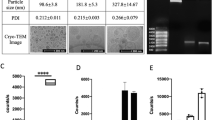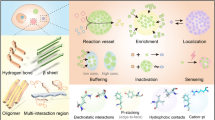Abstract
Electropermeabilisation is a well established physical method, based on the application of electric pulses, which induces the transient permeabilisation of the cell membrane. External molecules, otherwise nonpermeant, can enter the cell. Electropermeabilisation is now in use for the delivery of a large variety of molecules, as drugs and nucleic acids. Therefore, the method has great potential in the fields of cancer treatment and gene therapy. However many open questions about the underlying physical mechanisms involved remain to be answered or fully elucidated. In particular, the induced changes by the effects of the applied field on the membrane structure are still far from being fully understood. The present review focuses on questions related to the current theories, i.e. the basic physical processes responsible for the electropermeabilisation of lipid membranes. It also addresses recent findings using molecular dynamics simulations as well as experimental studies of the effect of the field on membrane components.




Similar content being viewed by others
Abbreviations
- PC:
-
Phosphatidyl-Choline
- PS:
-
Phosphatidyl-Serine
- PE:
-
Phosphatidyl-Ethanolamine
- SM:
-
Sphingomyelin
- DOPC:
-
1,2-Dioleoyl-sn-Glycero-3-Phosphocholine
- DOPS:
-
1,2-Dioleoyl-sn-Glycero-3-Phosphoethanolamine
- NBD:
-
7-Nitrobenz-2-oxa-1,3-diazol-4-yl
References
Abidor IG, Arakelyan VB, Chernomordik LV, Chizmadzhev YA, Pastushenko VF, Tarasevich (1979) Electric breakdown of bilayer membranes I: the main experimental facts and their qualitative description. Bioelectrochem Bioenerg 6:37–52
Antov Y, Barbul A, Mantsur H, Korenstein R (2005) Electroendocytosis: exposure of cells to pulsed low electric fields enhances adsorption and uptake of macromolecules. Biophys J 88:2206–2223
Barnett A, Weaver JC (1991) Electroporation: a unified, quantitative theory of reversible electrical breakdown and mechanical rupture in artificial planar bilayer membranes. Biolectrochem Bioenerg 25:163–182
Beebe SJ, Schoenbach KH (2005) Nanosecond pulsed electric fields: a new stimulus to activate intracellular signalling. J Biomed Biotechnol 4:297–300
Beebe SJ, White J, Blackmore PF, Deng Y, Somers K and Schoenbach KH (2003) Diverse effects of nanosecond pulsed electric fields on cells and tissues. DNA Cell Biol 22:785–796
Belehradek M, Domenge C, Luboinski B, Orlowski S, Belehradek J Jr, Mir LM (1993) Electrochemotherapy, a new antitumor treatment. First Clin Phase I-II Trial Cancer 72:3694–700
Bernhardt J, Pauly H (1973) On the generation of potential difference across the membrane of ellipsoidal cells in an alternating electric field. Biophysik 10:89–98
Bigey P, Bureau MF, Scherman D (2002) In vivo plasmid DNA electrotransfer. Curr Opin Biotechnol 13:443–447
Cartee LA, Plonsey R (1992) The transient subthreshold response of spherical and cylindrical cell models to extracellular stimulation. IEEE Trans Biomed Eng 39:76–85
Chen W (2005) Electroconformational denaturation of membrane proteins. Ann N Y Acad Sci 1066:92–105
Chen W, Lee RC (1994) Altered ion channel conductance and ionic selectivity induced by large imposed membrane potential pulse. Biophys J 67:603–612
Crowley JM (1973) Electrical breakdown of bimolecular lipid membranes as an electromechanical instability. Biophys J 13:711–24
Derjaguin BV, Gutop YV (1961) Theory of the breakdown (rupture) of free films. Kolloidn Zh 24:370–374
Devaux PF (2000) Is lipid translocation involved during endo-exocytosis? Biochimie 82:497–509
Dressler V, Schwister K, Haest CW, Deuticke B (1983) Dielectric breakdown of the erythrocyte membrane enhances transbilayer mobility of phospholipids. Biochim Biophys Acta 732:304–307
Favard C, Dean DS, Rols MP (2007) Electrotransfer as a non viral method of gene delivery. Curr Gene Ther 7:67–77
Gabriel B, Teissie J (1997) Direct observation in the millisecond time range of fluorescent molecule asymmetrical interaction with the electropermeabilized cell membrane. Biophys J 73:2630–2637
Gehl J, Sorensen TH, Nielsen K, Raskmark P, Nielsen SL, Skovsgaard T, Mir LM (1999) In vivo electroporation of skeletal muscle: threshold, efficacy and relation to electric field distribution. Biochim Biophys Acta 1428:233–240
Gilbert RA, Jaroszeski MJ, Heller R (1997) Novel electrode designs for electrochemotherapy. Biochim Biophys Acta 1334:9–14
Glaser RW, Leikin SL, Chernomordik LV, Pastushenko VF, Sokirko AI (1988) Reversible electrical breakdown of lipid bilayers and formation and evolution of pores. Biochem Biophys Acta 940:275–287
Golzio M, Teissie J, Rols MP (2002) Direct visualization at the single-cell level of electrically mediated gene delivery. Proc Natl Acad Sci U S A 99:1292–1297
Gowrishankar TR, Esser AT, Vasilkoski Z, Smith KC, Weaver JC (2006) Microdosimetry for conventional and supra-electroporation in cells with organelles. Biochem Biophys Res Comm 341:1266–1276
Haest CWM, Kamp D, Deuticke B (1997) Transbilayer reorientation of phospholipids probes in the human erythrocytes membrane. Lessons from studies on electroporated and resealed cells. Biochim Biophys Acta 1325:17–33
Hibino M, Itoh H, Kinosita K, (1993) Time courses of cell electroporation as revealed by submicrosecond imaging of transmembrane potential. Biophys J 64:1789–1800
Hol WGJ (1985) Effects of the alpha-helix dipole upon the functioning and structure of proteins and peptides. Adv Biophys 19:133–165
Isambert H (1998) Understanding the electroporation of cells and artificial bilayer membranes. Phys Rev Lett 80:3404–3407
Janmey PA and Kinnunen PKJ (2006) Biophysical properties of lipids and dynamics membranes. Trends Cell Biol 16:538–546
Karateki E, Sandre O, Guitouni H, Borghi N, Puech P-H, Brochard-Wyart F (2003) Cascades of transient pores in giant vesicles: Line tension and transport. Biophys J 84:1734–1749
Kolb JF, Kono S, Schoenbach KH (2006) Nanosecond pulsed electric field generators for the study of subcellular effects. Bioelectromagnetics 27:172–187
Kotnik T, Miklavcic D (2000) Analytical description of transmembrane voltage induced by electric field on spheroidal cells. Biophys J 79:670–679
Kotulska M, Kubica K, Koronkiewicz S, Kalinowski S (2007) Modeling of the induction of lipid membrane electropermeabilization. Bioelectrochemistry 70:64–70
Krassowka W, Filev PD (2007) Modeling electroporation in a single cell. Biophys J 92:404–417
Landau LD, Lifshitz EM (1975) Electrodynamics of continuous media. Pergamon Press, Oxford
Leontiadou H, Mark AE, Marrink SJ (2004) Molecular dynamics simulations of hydrophilic pores in lipid bilayers. Biophys J 86:2156–2164
Lin-Liu R, Adey WR, Poo MM (1984) Migration of cell surface concanavalin A receptors in pulsed electric fields. Biophys J 45:1211–1217
Mahrour N, Pologea-Moraru R, Moisescu MG, Orlowski S, Levêque P, Mir LM (2005) In vitro increase of the fluid-phase endocytosis induced by pulsed radiofrequency electromagnetic fields: importance of the electric field component. Biochem Biophys Acta 1668:126–137
McLaughlin S, Poo MM (1981) The role of electro-osmosis in the electric-field-induced movement of charged macromolecules on the surfaces of cells. Biophys J 34:85–93
Miklavcic D, Semrov D, Mekid H, Mir LM (2000) A validated model of in vivo electric field distribution in tissues for electrochemotherapy and for DNA electrotransfer for gene therapy. Biochim Biophys Acta 1523:73–83
Mir LM, Belehradek M, Domenge C, Orlowski S, Poddevin B, Belehradek J Jr, Schwaab G, Luboinski B, Paoletti C (1991a) Electrochemotherapy, a new antitumor treatment: first clinical trial. C R Acad Sci III 313:613–618
Mir LM, Orlowski S, Belehradek J Jr, Paoletti C (1991b) Electrochemotherapy potentiation of antitumour effect of bleomycin by local electric pulses. Eur J Cancer 27:68–72
Neu JC, Krassowska W (2003) Modeling postshock evolution of large electropores. Phys Rev E 67:021915–021926
Neu JC, Smith KC, Krassowska W (2003) Electrical energy required to form large conducting pores. Bioelectrochem Bioenerg 60:107–114
Neumann E, Rosenheck K (1972) Permeability changes induced by electric impulses in vesicular membranes. J Membr Biol 10:279–290
Neumann E, Sowers AE, Jordan CA (1989), Electroporation and electrofusion in cell biology. Plenum, New York
Pastushenko VF, Chizmadzhev YA, Arekelyan VB (1979) Electric breakdown of bilayer membranes II. Calculation of the membrane lifetime in the steady-state diffusion approximation. Bioelectrochem Bioenerg 6:53–62
Pavlin M, Pavselj, Miklavcic D (2002) Dependence of induced transmembrane potential on cll density, arrangement, and cell position inside a cell system. IEEE Trans Biomed Eng 49:605–612
Powell KT, Weaver JC (1986) Transient aqueous pores in bilayer membranes: a statistical theory. Bioelectrochem Bioenerg 15:211–227
Rols MP (2006) Electropermeabilization, a physical method for the delivery of therapeutic molecules into cells. Biochim Biophys Acta 1758:423–428
Sale AJ, Hamilton WA (1968) Effects of high electric fields on micro-organisms. 3. Lysis of erythrocytes and protoplasts. Biochim Biophys Acta 163:37–43
Sandre O, Moreaux L, Brochard-Wyart F (1999) Dynamics of transient pores in stretched membranes. Proc Nat Acad Sci USA 96:10591–10596
Schwan HP (1957) Electrical properties of tissue and cell suspensions. Adv Biol Med Phys 5:147–209
Sens P, Isambert H (2002) Undulation instability of lipid membranes under an electric field. Phys Rev Lett 88:128102–128105
Smith KC, Neu JC, Krassowska W (2004) Model of creation and evolution of stable electropores for DNA delivery. Biophys J 86:2813–2826
Sukharev SI, Klenchin VA, Serov SM, Chernomordik LV, Chizmadzhev Yu A (1992) Electroporation and electrophoretic DNA transfer into cells. The effect of DNA interaction with electropores. Biophys J 63:1320–1327
Susil R, Semerov D, Miklavcic (1998) Electric field-induced transmembrane potential depends on cell density and organization. Electro-Magnetobiol 17:391–399
Tarek M (2005) Membrane electroporation: a molecular dynamics simulation. Biophys J 88:4015–4053
Teissie J, Rols MP (1993) An experimental evaluation of the critical potential difference inducing cell membrane electropermeabilization. Biophys J 65:409–413
Teissie J, Tsong TY (1980) Evidence of voltage-induced channel opening in Na/K ATPase of human erythrocyte membrane. J Membr Biol 55:133–140
Teissie J, Eynard N, Vernhes MC, Benichou A, Ganeva V, Galutzov B, Cabanes PA (2002) Recent biotechnological developments of electropulsation. A prospective review. Bioelectrochemistry 55:107–112
Teissie J, Golzio M, Rols MP (2005) Mechanisms of cell membrane electropermeabilization: a minireview of our present (lack of ?) knowledge. Biochim Biophys Acta 1724:270–280
Tekle E, Oubrahim H, Dzekunov SM, Kolb JF, Schoenbach KH, Chock PB (2005) Selective field effects on intracellular vacuoles and vesicle membranes with nanosecond electric pulses. Biophys J 89:274–284
Tieleman DP (2004) The molecular basis of electroporation. BMC Biochem 5:10
Tieleman DP (2006) Computer simulations of transport through membranes:passive diffusion, pores, channels and transporters. Clin Exp Pharm Phys 33:893–903
Tsuji K, Neumann E (1983) Conformational flexibility of membrane proteins in electric fields I. Ultraviolet absorbance and light scattering of bacteriorhodopsin in purple membranes. Biophys Chem 17:153–163
Vernier PT, Sun Y, Marcu L, Craft CM, Gundersen MA (2004) Nanoelectropulse-induced phosphatidylserine translocation. Biophys J 86:4040–4048
Vernier PT, Ziegler MJ, Sun Y, Gundersen MA, Tieleman DP (2006a) Nanopore-facilitated, voltage-driven phosphatidylserine translocation in lipid bilayers-in cells and in silico. Phys Biol 3:233–247
Vernier PT, Sun Y, Gundersen MA (2006b) Nanoelectropulse-driven membrane perturbation and small molecule permeabilization. BMC Cell Biol 7:1–16
Weaver JC (1995) Electroporation theory. Concepts and mechanisms. Methods Mol Biol 55:3–28
Wilhelm C, Winterhalter M, Zimmermann U, Benz R (1993) Kinetics of pore size during irreversible electric breakdown of lipid bilayer membranes. Biophys J 64:121–128
Winterhalter M, Helfrich W (1987) Effect of voltage on pores in membranes. Phys Rev A 36:5874–5876
Wohlert J, den Otter WK, Edholm O, Briels WJ (2006) Free energy of a trans-membrane pore calculated from atomist molecular dynamics simulations. J Chem Phys 124:154905–154914
Yurong Q, Shengli L, Yuehua J, Taicheng Y, Jie W (2005) Transmembrane voltage induced on a cell membrane in suspensions exposed to an alternating field: a theoretical analysis. Bioelectrochemistry 67:57–65
Zhao M, Dick A, Forrester JV and McCaig CD (1999) Electric field-directed cell motility involves up-regulated expression and asymmetric redistribution of the epidermal growth factor receptors and is enhanced by fibronectin and laminin. Mol Biol 10:1259–1276
Zhelev DV, Needham D (1993) Tension stablized pores in giant vesciles: determination of pore size and pore line tensions. Biophys Acta 1147:89–104
Zimmermann U, Pilwat G, Riemann F (1974) Dielectric breakdown of cell membranes. Biophys J 14:881–899
Acknowledgments
This work was supported by the Association Française contre les Myopathies.
Author information
Authors and Affiliations
Corresponding authors
Rights and permissions
About this article
Cite this article
Escoffre, JM., Dean, D.S., Hubert, M. et al. Membrane perturbation by an external electric field: a mechanism to permit molecular uptake. Eur Biophys J 36, 973–983 (2007). https://doi.org/10.1007/s00249-007-0194-7
Received:
Revised:
Accepted:
Published:
Issue Date:
DOI: https://doi.org/10.1007/s00249-007-0194-7




